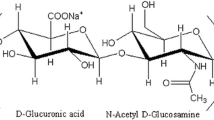Abstract
Cigarette smoke has been implicated in the pathogenesis of a variety of diseases that affect connective tissues. The effect of the gas phase of cigarette smoke on hyaluronic acid was investigated in vitro. The smoke markedly reduced the chain length of purified hyaluronic acid as assessed by both viscometry and gel chromatography. The hyaluronate exposed to smoke, nevertheless, could aggregate proteoglycans, although the viscosity of the aggregates was lower than in those formed with the unexposed material. The degradation of the hyaluronate was a rapid phenomenon and was inhibited by dimethylsulfoxide, a known scavenger of hydroxyl radicals. We conclude that free radicals in the gas phase of cigarette smoke degrade hyaluronic acid in vitro.
Similar content being viewed by others
References
Cleland LG, Betts WH, Vernon-Roberts B, Bielicki J (1982) Role of iron and influence of antiinflammatory drugs on oxygen-derived free radical production and reactivity. J Rheumatol 9:885–892
Curran SF, Amoruso MA, Goldstein BD, Berg RA (1984) Degradation of soluble collagen by ozone or hydroxyl radicals. FEBS Lett 176:155–160
Dabrowski R, Maslinski C (1975) Collagen, glycosaminoglycans and histamine in lungs of guinea pigs exposed chronically to cigarette smoke. Bull Acad Pol Des Sci 23:125–128
Del Maestro RF, Arfors KE, Lindblom R (1978) Free radical depolymerization of hyaluronic acid: influence of scavenger substances. Bibl Anat 18 (Suppl) 132–135
Dooley HM, Pryor NA (1982) Free radical pathology: inactivation of human-1-proteinase inhibitor by products from the reaction of nitrogen dioxide with hydrogen peroxide and the etiology of emphysema. Biochem Biophys Res Commun 106:981–987
Fligiel SE, Lee EC, McCoy JP, Johnson KJ, Varani J (1984) Protein degradation following treatment with hydrogen peroxide. Am J Pathol 115:418–425
Fox RB, Fox WK (1983) Dimethyl sulfoxide prevents hydroxyl radical-mediated depolymerization of hyaluronic acid. Ann NY Acad Sci 411:41–48
Greenwald RA, Moy WW (1980) Effect of oxygen-derived free radicals on hyaluronic acid. Arthritis Rheum 23:455–463
Halliwell B (1978) Superoxide-dependent formation of hydroxyl radicals in the presence of iron salts. FEBS Lett 96:238–242
Hascall VC (1977) Interaction of cartilage proteoglycans with hyaluronic acid. J Supramol Struct 7:101–120
Hascall VC, Kimura JH (1982) Proteoglycans: isolation and characterization. In: Cunnigham LW, Frederiksen DW (eds) Methods in enzymology, Vol. 82. Academic Press, New York pp 769–800
Heinengard D (1972) Extraction, fractionation and characterization of proteoglycans from bovine tracheal cartilage. Biochim Biophys Acta 285:181–192
Heinegard D (1973) Automated procedures for the determination of protein and uronic acid in column effluents. Chem Scripta 4:199–201
Hofman H, Schmut O (1980) The inability of superoxide dismutase to inhibit the depolymerization of hyaluronic acid by ferrous ions and ascorbate. Graefes Arch Klin Ophthalmol 214:181–185
Jahnke MR, McDevitt CA (1988) Proteoglycans of the intervertebral disc: electrophoretic heterogeneity of the aggregative proteoglycans of the nucleus pulposus. Biochem J 251:347–356
Kew RR, Ghebrehiwet B, Janoff A (1985) Cigarette smoke can activate the alternative pathway of complementin vitro by modifying C3. J Clin Invest 75:1000–1007
Konno K, Arai H, Motomiya M, Nagai H, Ito M, Sato H, Satoh K (1982) A biochemical study on glycosaminoglycans (mucopolysaccharides) in emphysematous and in aged lungs. Am Rev Respir Dis 126:797–801
Laterra J, Culp LA (1982) Differences in hyaluronate binding to plasma and cell surface fibronectins. J Biol Chem 257:719–726
McCord JM (1974) Free radicals and inflammation: protection of synovial fluid by superoxide dismutase. Science 185:529–531
McCord JM, Day ED (1978) Superoxide-dependent production of hydroxyl radical catalyzed by iron-EDTA complex. FEBS Lett 86:139–142
Pryor WA, Tamura M, Church DF (1984) ESR spin-trapping study of the radicals produced in NO2/Olefin reactions: A mechanism for the production of the apparently long-lived radicals in gas-phase cigarette smoke. J Am Chem Soc 106:5073–5079
Riley DJ, Kerr JS (1985) Oxidant injury of the extracellular matrix: potential role in the pathogenesis of pulmonary emphysema. Lung 163:1–13
Roden L, Baker JR, Cifonelli JA, Mathews M (1972) Isolation and characterization of connective tissue polysaccharides. In: Ginsburg V (ed) Methods in enzymology, XXVII, Part B. Academic Press, New York pp 73–140
Rosner B (1986) Fundamentals of biostatistics, 2nd edition. Duxbury Press, Boston, MA
Sommarin Y, Heingegard D (1983) Specific interaction between cartilage proteoglycans and hyaluronic acid at the chondrocyte cell surface. Biochem J 214:777–784
Toole BP (1981) Glycosaminoglycans in morphogenesis. In: Hay E (ed) Cell biology of extracellular matrix. Plenum, New York pp 259–294
Turley E, Moore D (1984) Hyaluronate binding proteins also bind to fibronectin, laminin and collagen. Biochem Biophys Res Commun 111:808–814
U.S. Public Health Service Smoking and Health (1979) A Report of the Surgeon General. U.S. Government Printing Office, Washington DC DHEW (PHS) 70-50066
Wong SF, Halliwell B, Richmond R, Skowroneck, WR (1981) The Role of superoxide and hydroxyl radicals in the degradation of hyaluronic acid induced by metal ions and by ascorbic acid. J Inorg Biochem 14:127–134
Author information
Authors and Affiliations
Rights and permissions
About this article
Cite this article
McDevitt, C.A., Beck, G.J., Ciunga, M.J. et al. Cigarette smoke degrades hyaluronic acid. Lung 167, 237–245 (1989). https://doi.org/10.1007/BF02714952
Accepted:
Issue Date:
DOI: https://doi.org/10.1007/BF02714952




